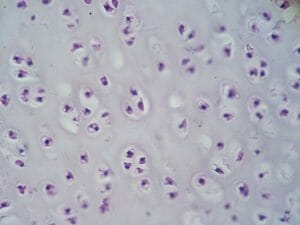Hyaline Cartilage Definition
Hyaline cartilage is a type of connective tissue found in areas such as the nose, ears, and trachea of the human body. The word hyaline means “glass-like”, and hyaline cartilage is a glossy, greyish-white tissue with a uniform appearance. It is one of the three types of cartilage; the other two types are elastic cartilage and fibrocartilage. Hyaline cartilage is the most abundant type of cartilage in the body.
Function of Hyaline Cartilage
Hyaline cartilage is high in collagen, a protein that is found not only in connective tissue but also in skin and bones, and helps hold the body together. Hyaline cartilage provides support and flexibility to different parts of the body. It is found in structures like the nose, ears, and areas where the ends of the ribs attach to the sternum, and in parts of the respiratory system like the trachea and larynx, where it helps give these parts their form but also gives them some flexibility.
When hyaline cartilage is on the articular surfaces of bones (the surfaces at joints), it is called articular cartilage. Articular cartilage functions as a shock absorber and also reduces friction between bones where they meet at joints. As a person ages, this cartilage can wear away, leading to joint pain and swelling that is sometimes only alleviated by surgery.
Structure of Hyaline Cartilage
As mentioned before, hyaline cartilage contains a lot of collagen; it contains type II, specifically. Type I is found in bones, organs, skin, and tendons, and most of the collagen in the human body is type I. However, cartilage is composed of type II. Hyaline cartilage also contains the molecule chondroitin sulfate, which helps it to resist being compressed. However, it is the weakest of the three types of cartilage because its collagen fibers are very fine.
Cartilage tissue does not have nerves or blood vessels. Instead, it has a simple structure that is mainly made up of groups of cells called chondrocytes embedded in an intracellular matrix. The protoplasm (inside content of the cell) is clear, and the cells have one or two nuclei. Chondrocytes are found in lacunae, which are small cavities that surround the chondrocytes. A primary lacuna is a lacuna containing one chondrocyte. When that cell divides, the daughter cells form new boundary layers called secondary lacunae, and the group of cells with lacunae is called a cell nest.
Hyaline cartilage is very uniform in appearance. It is surrounded by a membrane called the perichondrium, which provides nutrients to the cartilage since the cartilage tissue has no blood vessels of its own.

This is an image of hyaline cartilage in the trachea viewed through a microscope at 400x magnification. The dark spots are chondrocytes, while the light-colored circles surrounding them are the lacunae. In microscope images, the collagen in hyaline cartilage is not visible because it is so fine. The other types of cartilage, elastic and fibrocartilage, have visible collagen when viewed under a microscope.
Other Types of Cartilage
Elastic Cartilage
Elastic cartilage, also called yellow cartilage, is found in the outer ear, the Eustachian (auditory) tube, and the epiglottis, which is the tissue that separates the trachea and the esophagus. It is similar to hyaline cartilage and has yellow elastic fibers that make it very flexible. Its role is to give shape and support to these areas.
Fibrocartilage
Fibrocartilage is found in areas like the pubic symphysis (where the pubic bones meet), disks between vertebrae of the spine, and the temporomandibular (jaw) joint. It contains cartilage tissue and white fibrous tissue. Also, it is the only type of cartilage that has both type I and type II collagen. It is flexible, tough, and elastic.
Related Biology Terms
- Cartilage – Tough but flexible connective tissue found in places such as the nose, ear, joints, and respiratory system.
- Collagen – A protein that is found in skin and connective tissue; it is the most common protein in the human body.
- Fiber (anatomy) – An elongated filament found in connective tissue.
- Perichondrium – A layer of connective tissue that surrounds hyaline cartilage and elastic cartilage; it has roles in growth, repair, and providing nutrients to cartilage.
Quiz
1. When is hyaline cartilage called articular cartilage?
A. When it is surrounded by the perichondrium
B. When it contains chondrocytes
C. When it is found on the larynx
D. When it is found at joints where bones meet
2. Which is NOT one of the three types of cartilage?
A. Elastic
B. Hyaline
C. Mesocartilage
D. Fibrocartilage
3. What type of collagen is found in hyaline cartilage?
A. Type I
B. Type II
C. Type III
D. Type IV
